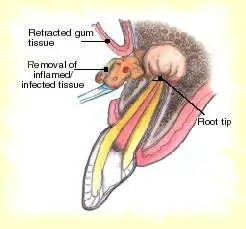To understand endodontic surgery, it helps first to know something about the nonsurgical endodontic procedure, or "root canal." A root canal is necessary when the soft inner tissue, or "pulp," of the tooth becomes inflamed or infected. This may happen as a result of deep decay, repeated dental procedures on the tooth, or a blow to the tooth. Endodontic treatment removes the damaged pulp. Then the tooth's canals are cleaned and filled to help preserve the tooth.
In a few cases, however, nonsurgical endodontic treatment alone cannot save the tooth. In such a case, your dentist or endodontist may recommend surgery.
Why Endodontic Surgery Is Needed
Surgery can help save your tooth in a variety of situations:
Surgery may be used in diagnosis. If you have persistent symptoms but no problems appear on your x-ray, your tooth may have a tiny fracture or canal that could not be detected during nonsurgical treatment. In such a case, surgery allows your endodontist to examine the root of your tooth, find the problem, and provide treatment.
Sometimes calcium deposits make a canal too narrow for the cleaning and shaping instruments used in nonsurgical root canal treatment to reach the end of the root. If your tooth has this "calcification," your endodontist may perform endodontic surgery to clean and seal the remainder of the canal.
Usually, a tooth that has undergone a root canal can last the rest of your life and never need further endodontic treatment. However, in a few cases, a tooth may fail to heal. The tooth may become painful or diseased months or even years after successful treatment. If this is true for you, surgery may help save your tooth.
Surgery may also be performed to treat damaged root surfaces or surrounding bone.

What is an Apicoectomy?


A small filling may be placed to seal the end of the root canal, and a few stitches or sutures are placed in the gum to help the tissue heal properly.

Other Types of Endodontic Surgery
Endodontists might perform other surgeries such as dividing a tooth in half, repairing an injured root, or even removing one or more roots. Your endodontist will be happy to discuss the specific type of surgery your tooth requires.
In very complex cases, a procedure called intentional replantation may be performed. In this procedure, a tooth is extracted, treated with an endodontic procedure while it is out of the mouth and then replaced in its socket.
These procedures are designed to help you save your tooth.
Patient Care Instructions Following Endodontic Surgery
- Avoid strenuous exercise for the remainder of the day. Smoking and alcohol consumption delay wound healing and should be avoided for 3 days following surgery. Physical exertion or heavy lifting should not be performed for 7 to 10 days after your surgery.
- Apply an ice pack with firm pressure to your face directly over the surgical site. You should apply the ice pack alternately 20 minutes on and 20 minutes off for 6 to 8 hours following your surgery. After 8 hours, the ice bag should not be applied. Frequent moist heat applications to your face are recommended on the second and third post surgical days. To make an ice pack, fill one half of a zip lock bag with water and the rest with 70% isopropyl (rubbing) alcohol, seal and then freeze.
- Slight swelling and facial skin discoloration (bruising) may appear following surgery and will gradually disappear in a few days. Some oozing of blood from the surgical site is normal during the day and evening following the surgery. If actual bleeding occurs, please call the office.
- Avoid manipulation of your facial tissues as much as possible. Do NOT raise your lip or retract your cheeks to look at the surgical site. Try to sleep on your back or away from the side on which your surgery was done. It is possible to tear loose the stitches accidentally, which will open the incision and substantially delay wound healing.
- Please make sure to maintain an adequate diet during the first 3 to 4 days following your surgery. Eat a soft or liquid diet such as nutritional supplements, mashed potatoes, pureed meats, cooked eggs, fruit juices, soups, etc. Avoid crunchy, hard or chewy foods such as crackers, toast, steak and the like until the sutures has been removed. Drink plenty of liquids.
- Post surgical discomfort should be minimal after the second day but the surgical site may remain tender and sore for 4 to 5 days following your surgery. Please have your prescriptions filled as soon as possible and follow the directions on the labels. If you develop any unusual reactions (itching, rash, breathing difficulties, etc.), please stop taking the medication and call the office immediately.
- Do NOT brush the surgical site for at least 10 days following the surgery. Do brush other parts of your mouth and use a warm salt rinse, if desired, after meals. (1/4 to ½ teaspoon salt in an 8 oz. glass of warm water). Rinse with Peridex as directed beginning on the day after surgery.
- Rest as much as possible the first 24 hours. Elevate your head with at least two pillows when lying or at bedtime. Sleep on your back or away from the surgical site.
- The sutures (stitches) should be removed in 3 to 7 days to ensure proper healing. Make sure to return at the appointed time for removal.
- Recall visits are necessary. These are short appointments that are very important to monitor the progress of healing. Recall appointments will be scheduled during the first few weeks following surgery and another appointment 6 months after surgery.
***If any unusual symptoms develop, please contact the office for advice and instructions. ***
Parts of this content are provided courtesy of the American Association of Endodontics, Copyright 1996. For more information, please link to their website at http://www.aae.org/
